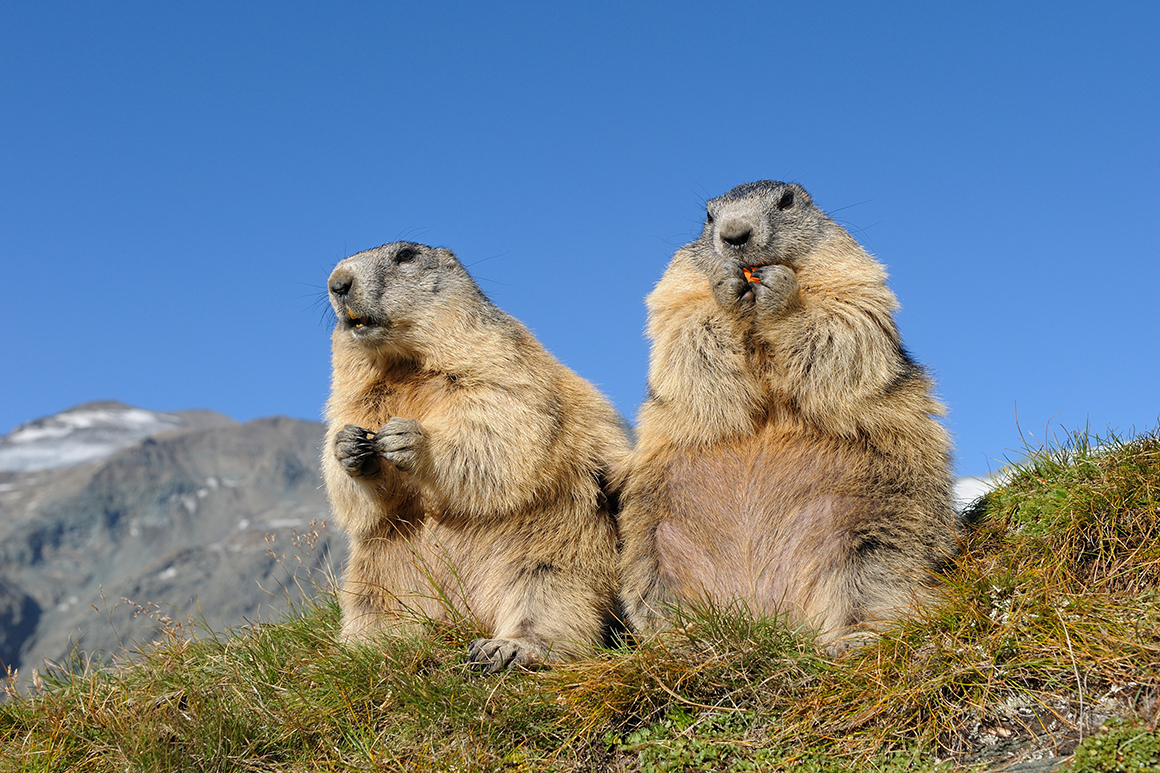How Much Rock Could a Rockchuck Chuck
You’ve probably never heard of the gold-digging ants of Persia. I know I hadn’t. Twenty-five-hundred years ago, the historian Herodotus told of ants larger than foxes but smaller than dogs, that burrowed for gold; and most thought the ancient Greek had been eating too much lotus. Then about 20 years ago a French anthropologist-explorer found that true to its name the long-tailed, or golden, marmot, Marmota caudata, of northern Pakistan, when burrowing in ore-bearing layers of sand, came out with gold dust in its fur that could be collected.

Marmots are strange animals, even if not as strange as giant gold-mining ants. There are 14 species around the world in the Northern Hemisphere, with the ones in North America, as a whole, the third-largest native rodents on the continent, growing to as much as 15 pounds. They also live sometimes at elevation, such as the yellow-bellied marmot (Marmota flavivertis) whose habitat generally begins at 6,500 feet. It is called the “rockchuck” to differentiate it from the lower-altitude “woodchuck” or groundhog. (Because of their whistling alarm call, they are also known as “whistle pigs.”)
Marmots hibernate for eight months of the year, which means they spend most of their lives in their burrows, where badgers dig down to prey on young ones. In many parts of the world, such as Mongolia, they are prized as food. Native Americans of the Great Basin called the rockchuck ya ha and from spring till fall, during the period when ’chucks were out of hibernation, they baked them whole in a pit with heated stones. And as unusual as it may sound, they were said to taste, not at all like chicken, but like rich pork. In the Alps their fat is used to medicate rheumatoid conditions. And in the Alps as well, they are hunted like big game with substantial trophy fees, up to hundreds of euros.

In many Rocky Mountain states, the rockchuck is classified as a “varmint,” or more officiously as a “non-game” animal, meaning it may be hunted at any time (check game regulations first), though a hunting license is almost always required. It lives in a variety of habitats; but rocky outcrops, cut-banks, and talus slopes are common denominators. Its burrows will often be in proximity to green fields of wild grasses and forbs or agricultural crops. It emerges in the early morning to sun itself, feeds, lounges and grooms, goes to ground for a time at midday, then comes back out in the late afternoon to feed further.
For varmint hunters, rockchucks are either small big game or big small game; but they are certainly mountain game, making them excellent practice for sheep and goat hunters, and high-altitude elk and deer hunters. So hunting them with your big-game rifle and Browning ammunition can make sense in the summer months before the fall.
It also makes sense to hunt them because of the severe damage they can do to farms (not just through plant depredation but by their burrows that can injure livestock and damage equipment when the ground collapses underneath them). Add to that the spectrum of diseases they can carry, from sylvatic plague to being hosts for the ticks that communicate Rocky Mountain spotted fever to the diarrheal intestinal disease, cryptosporidiosis, spread through their droppings (all of which makes honoring the tradition of eating them a rather dodgy proposition).
For hunting rockchucks for their own sake, there are good choices of Browning predator ammunition to choose from. But go back to the consideration of a big-game bullet like the Browning BXR Rapid Expansion Matrix Tip cartridge in the 97-grain 243 Winchester loading. A veteran Idaho rockchuck hunter I knew some years back picked the 243 for shots across the Snake River Canyon. At the extreme ranges and in the gusty winds that almost never let up there, the high ballistic coefficient and velocity of the 243 put it reliably on the target. And again, this gives you the option of hunting in the fall with the same cartridge and bullet load you practiced with in the summer.
You may not strike gold in rockchuck hunting, but it can definitely provide many other kinds of riches.
Follow Browning Ammunition’s social media channels for more hunting and shooting tips and updates on Browning Ammunition supported events and promotions on Facebook, You Tube, Instagram and Twitter.



